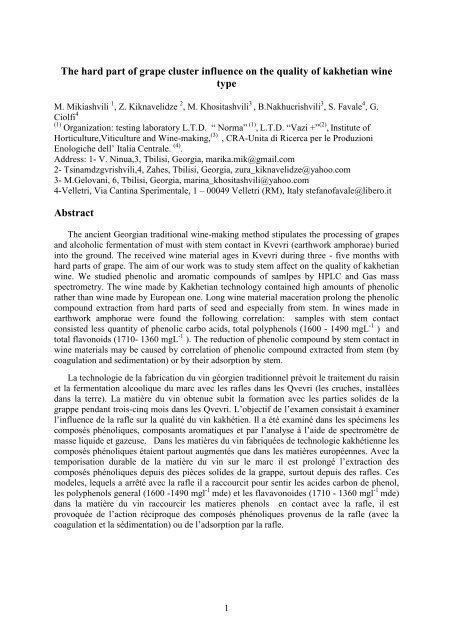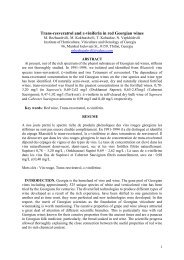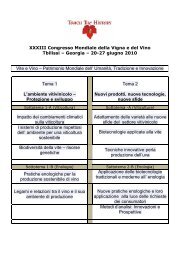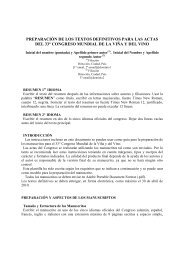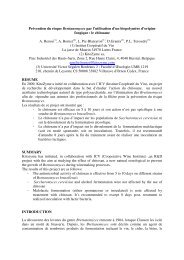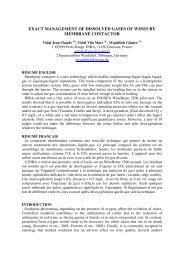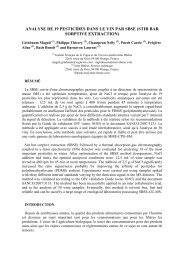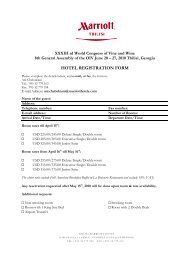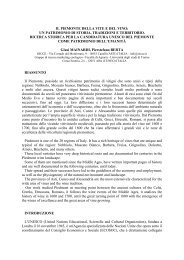Characterization of Georgian white grape wines made ... - Oiv2010.ge
Characterization of Georgian white grape wines made ... - Oiv2010.ge
Characterization of Georgian white grape wines made ... - Oiv2010.ge
You also want an ePaper? Increase the reach of your titles
YUMPU automatically turns print PDFs into web optimized ePapers that Google loves.
The hard part <strong>of</strong> <strong>grape</strong> cluster influence on the quality <strong>of</strong> kakhetian wine<br />
type<br />
M. Mikiashvili 1 , Z. Kiknavelidze 2 , M. Khositashvili 3 , B.Nakhucrishvili 3 , S. Favale 4 , G.<br />
Ciolfi 4<br />
(1) Organization: testing laboratory L.T.D. ― Norma‖ (1) , L.T.D. ―Vazi +‖ (2) , Institute <strong>of</strong><br />
Horticulture,Viticulture and Wine-making, (3) , CRA-Unita di Ricerca per le Produzioni<br />
Enologiche dell’ Italia Centrale. (4) .<br />
Address: 1- V. Ninua,3, Tbilisi, Georgia, marika.mik@gmail.com<br />
2- Tsinamdzgvrishvili,4, Zahes, Tbilisi, Georgia, zura_kiknavelidze@yahoo.com<br />
3- M.Gelovani, 6, Tbilisi, Georgia, marina_khositashvili@yahoo.com<br />
4-Velletri, Via Cantina Sperimentale, 1 – 00049 Velletri (RM), Italy stefan<strong>of</strong>avale@libero.it<br />
Abstract<br />
The ancient <strong>Georgian</strong> traditional wine-making method stipulates the processing <strong>of</strong> <strong>grape</strong>s<br />
and alcoholic fermentation <strong>of</strong> must with stem contact in Kvevri (earthwork amphorae) buried<br />
into the ground. The received wine material ages in Kvevri during three - five months with<br />
hard parts <strong>of</strong> <strong>grape</strong>. The aim <strong>of</strong> our work was to study stem affect on the quality <strong>of</strong> kakhetian<br />
wine. We studied phenolic and aromatic compounds <strong>of</strong> samlpes by HPLC and Gas mass<br />
spectrometry. The wine <strong>made</strong> by Kakhetian technology contained high amounts <strong>of</strong> phenolic<br />
rather than wine <strong>made</strong> by European one. Long wine material maceration prolong the phenolic<br />
compound extraction from hard parts <strong>of</strong> seed and especially from stem. In <strong>wines</strong> <strong>made</strong> in<br />
earthwork amphorae were found the following correlation: samples with stem contact<br />
consisted less quantity <strong>of</strong> phenolic carbo acids, total polyphenols (1600 - 1490 mgL -1 ) and<br />
total flavonoids (1710- 1360 mgL -1 ). The reduction <strong>of</strong> phenolic compound by stem contact in<br />
wine materials may be caused by correlation <strong>of</strong> phenolic compound extracted from stem (by<br />
coagulation and sedimentation) or by their adsorption by stem.<br />
La technologie de la fabrication du vin géorgien traditionnel prévoit le traitement du raisin<br />
et la fermentation alcoolique du marc avec les rafles dans les Qvevri (les cruches, installées<br />
dans la terre). La matière du vin obtenue subit la formation avec les parties solides de la<br />
grappe pendant trois-cinq mois dans les Qvevri. L’objectif de l’examen consistait à examiner<br />
l’influence de la rafle sur la qualité du vin kakhétien. Il a été examiné dans les spécimens les<br />
composés phénoliques, composants aromatiques et par l’analyse à l’aide de spectromètre de<br />
masse liquide et gazeuse. Dans les matières du vin fabriquées de technologie kakhétienne les<br />
composés phénoliques étaient partout augmentés que dans les matières européennes. Avec la<br />
temporisation durable de la matière du vin sur le marc il est prolongé l’extraction des<br />
composés phénoliques depuis des pièces solides de la grappe, surtout depuis des rafles. Ces<br />
modeles, lequels a arrêté avec la rafle il a raccourcit pour sentir les acides carbon de phenol,<br />
les polyphenols general (1600 -1490 mgl -1 mde) et les flavavonoides (1710 - 1360 mgl -1 mde)<br />
dans la matière du vin raccourcir les matieres phenols en contact avec la rafle, il est<br />
provoquée de l’action réciproque des composés phénoliques provenus de la rafle (avec la<br />
coagulation et la sédimentation) ou de l’adsorption par la rafle.<br />
1
Introduction<br />
The main subject <strong>of</strong> various published works about wine compounds, is the study <strong>of</strong><br />
phenolic and volatile ones, because they are very important contributors for wine sensory<br />
properties — colour, flavour, astringency, and bitterness (Arnold and Noble 1978,Arnold et<br />
al.1980, Cocito et al. 1995, Kotseridis and Baumes 2000, Powers et al. 1988, Singleton 1992).<br />
It is well known that for given <strong>grape</strong> varieties, the kind <strong>of</strong> winemaking technology can<br />
notably affect the levels <strong>of</strong> phenolic and volatile compounds <strong>of</strong> wine. Wines <strong>made</strong> by skin<br />
fermentation with stem-contact contained much more polymeric phenols than those <strong>made</strong> by<br />
skin fermentation without stem-contact wine, and extending pomace contact time increased<br />
both total and polymeric phenol levels in <strong>wines</strong> (Kantz and Singleton 1991). Stem contact<br />
<strong>wines</strong> contained much higher concentration <strong>of</strong> proanthocyanidins than non-stem contact<br />
<strong>wines</strong> (Bourzeix et al. 1986, Spranger et al. 2004, Sun et al. 2001), due to the important<br />
transference <strong>of</strong> this compounds from stems to <strong>wines</strong> during fermentation (Sun et al.<br />
1999).The aroma <strong>of</strong> <strong>white</strong> and red <strong>wines</strong> is the product <strong>of</strong> a biochemical and technological<br />
succession and it is decisively influenced by the alcoholic fermentation procedure (Bayonove<br />
et al. 1998, Rapp 1988). The complexity <strong>of</strong> wine aroma is defined by all technical factors. As<br />
many viticulture and oenological factors greatly influence the types and concentrations <strong>of</strong><br />
flavour components (Zhou et al. 1996), the ability to define each individual component would<br />
provide an approach to optimize the operational conditions, mainly the winemaking<br />
technologies.<br />
Viticulture and wine making in Georgia have been widely practiced since ancient time<br />
(Olmo 1976, Zohary and Hopf 1993, Zohary and Spiegel-Roy 1975).Continuous and<br />
intensive selection <strong>of</strong> <strong>grape</strong> varieties that favoured the production <strong>of</strong> desired wine styles led<br />
over the centuries to a plenty <strong>of</strong> native cultivars, which possess various distinct oenological<br />
characteristics and organoleptic properties. Good example <strong>of</strong> variety <strong>of</strong> <strong>Georgian</strong> winemaking<br />
is local type Kakhetian wine, which is <strong>made</strong> in earthwork amphorae (Beridze 1965)<br />
by using all parts <strong>of</strong> <strong>grape</strong> during fermentation and the first step <strong>of</strong> wine aging (Marjanishvili<br />
1983, Nanitashvili 1978, Valero et al. 2002). Because <strong>of</strong> this, wine is characterized with<br />
varietal aroma, high extract and polyphenolic consistence. For the production <strong>of</strong> this type <strong>of</strong><br />
<strong>white</strong> wine are always used the following <strong>grape</strong> varieties: Rkatsiteli (V. vinifera L.) and<br />
Kakhuri Mtsvane (V. vinifera L.).<br />
The object <strong>of</strong> our work was to study characteristic consistence <strong>of</strong> Kakhetian wine type<br />
<strong>made</strong> in earthwork amphorae using different <strong>grape</strong> varieties from diverse areas and prepared<br />
in different way.<br />
Materials and methods<br />
Standards<br />
Used materials: (+)-catechin, (-)-epicatechin, hexyl acetate, ethyl hexanoate, ethyl<br />
decanoate, ethyl lactate, ethyl octanoate, (Sigma, USA), procyanidin B1 (Extrasynthèse,<br />
France), caffeic acid , geraniol, nerol, linalool, benzyl alcohol, ethyl 3-OH-butyrate (Fluka,<br />
Switzerland), α-terpineol, gallic acid, 2-phenyl ethanol, isoamyl acetate, hexanoic, octanoic<br />
and decanoic acids (Merck-Schuchardt, Germany), 2-phenyl ethyl acetate, diethylsuccinate<br />
(Carlo Erba, Italy).<br />
Winemaking technologies<br />
Grapes were harvested in September 2007 at a technological maturation. All parts <strong>of</strong><br />
<strong>grape</strong>s were processed in earthwork amphorae: Kakhuri Mtsvane from Akhmeta region,<br />
Rkatsiteli from Kardenakhi region and the same variety from Gurjaani region – all without<br />
stem contact and also Rkatsiteli from Kardenakhi region with stem contact. Fermentation<br />
2
proceeded 10-12 days, with stirring every 6 hours and approximate temperature – 20°C,<br />
thanks to spontaneously cooling (which takes place by good thermoconductivity <strong>of</strong> earthwork<br />
amphorae in the ground); at the end <strong>of</strong> fermentation and filling-up, SO 2 (30 mgL -1 ) was<br />
added; <strong>wines</strong> were left in earthwork amphorae until March <strong>of</strong> next year, then transferred to<br />
stainless steel tanks and stored at room temperature before analyses.<br />
Chemical and physical parameters <strong>of</strong> <strong>wines</strong><br />
Alcohol content, pH, total acidity, volatile acidity and chromatic characteristic were <strong>made</strong><br />
according to the <strong>of</strong>ficial methods <strong>of</strong> O.I.V. (1990).<br />
Spectrophotometric analysis<br />
Total polyphenols, flavans and flavonoids were determined according to Di Stefano et. al.<br />
(1989).<br />
HPLC analyses<br />
Catechins and hydroxycinnamic acids were performed according to Ummarino et al.<br />
(2001). Instrument was as follows: degasser, quaternary pump, thermostated column<br />
compartment (Agilent Technologies, 1100 series, USa), autosampler, DAD detector (Agilent<br />
Technologies, 1200 series, USA); guard column ODS-Hypersil (C18) 20 x 2.1 mm-5µm (CPS<br />
Analitica, Italy); column ODS Hypersil 200 x 2.1 mm – 5µm (CPS Analitica, Italy) for<br />
catechins and hydroxycinnamic acid. Quantities were expressed as mgL -1 for wine;<br />
particularly, hydroxycinnamic acids were expressed as mgL -1 <strong>of</strong> caffeic acid.<br />
Volatile compounds<br />
Volatile compounds were determined by gas chromatography as described in literature<br />
(Gianotti and Di Stefano 1991). Chromatographic conditions were: instrument GC 8000<br />
(Fisons Instruments, Italy), detector FID, helium flow 2.9 mLmin -1 , column HP- FFAP 50 m<br />
x 0.32 mm x 0.50 µm (Agilent Technologies, USA), injection temperature 220 °C, oven<br />
temperature 33 °C held for 5 min, then 3 °C min -1 to 200 °C, then isotherm for 10 min, then<br />
10 °C min -1 till 220°C and isotherm 220°C for 15 min. Detector temperature was 245 °C, and<br />
injection volume - 3 µL. Commercial standards were used in order to identify and quantify<br />
volatile compounds in sample, added with 1-heptanol as internal standard.<br />
Varietal compounds<br />
Glycosidically bound varietal compounds from <strong>wines</strong> were determined according to Di<br />
Stefano (1996). For enzymatic hydrolysis, overnight at 40°C, Cytolase (Genecor) was used.<br />
The analyses were carried out by GC HP 5890 Serie II and MS HP 5972, column HP-<br />
Innowax 30 m x 0.25 mm x 0.25 µm, splitless injection 2 µL, helium flow 1 mLmin -1 ; starting<br />
temperature 30°C for 2 min, oven temperature 30°C min -1 from 30°C to 60°C, 2°C min -1 up to<br />
160°C, 3°C min -1 up to 230°C, and then held for 10 min. Commercial compounds were used<br />
for calibration, with internal standard method. 200 µL <strong>of</strong> 1-heptanol (67,6 mgL -1 in<br />
methanol/H 2 O 20% v/v ) were added as internal standard. The concentration <strong>of</strong> each varietal<br />
compound was expressed in µgL -1 , and in µg <strong>of</strong> linalool per litre <strong>of</strong> wine, when commercial<br />
standard was not available.<br />
Results<br />
The general compositions <strong>of</strong> different <strong>wines</strong> are shown in Tab.1. From this table, it can be<br />
seen, that between Rkatsiteli Kardenakhi samples fermented with and without stem contact,<br />
there is not difference in all analysed factors, thus according to Ribereau-Gayon et al. (2000)<br />
<strong>wines</strong> fermented without destemming must contain less volumes <strong>of</strong> alcohol and acidity. It can<br />
be underlined a little difference in chromatic characterization, that comes among <strong>wines</strong> with<br />
3
stem contact and all <strong>wines</strong> – without. Rkatsiteli from Kardenakhi fermented and aged with<br />
stem contact, had less purity and less brightness than <strong>wines</strong> vinified without stems.<br />
Names<br />
Table 1 General composition <strong>of</strong> amphorae <strong>wines</strong><br />
alcohol<br />
(% v/v)<br />
tot.<br />
acidity<br />
(gL -1<br />
tartaric<br />
acid)<br />
volatile<br />
acidity<br />
(gL -1<br />
acetic<br />
acid)<br />
pH purity brightness<br />
Dom.<br />
wave<br />
length<br />
Kakhuri Mtsvane 12,7 5,1 0,48 3,47 16,02 91,22 575,85<br />
Rkatsiteli Kardenakhi 11,9 5,2 0,44 3,49 12,29 92,86 576,07<br />
Rkatsiteli Gurjaani 12,6 5,7 0,41 3,22 13,15 92,43 576,22<br />
Rkatsiteli Kardenakhi with stems 11,8 5,0 0,54 3,45 6,67 85,75 577,19<br />
The amounts <strong>of</strong> volatile compounds determined by gas-chromatography in Rkatsiteli and<br />
Mtsvane <strong>grape</strong> <strong>wines</strong> are presented in Tab. 2.<br />
The reported metabolites, even if they were expression <strong>of</strong> a particular vinification process,<br />
did not let a punctual analysis about their origin because <strong>of</strong> the unknown development <strong>of</strong><br />
micr<strong>of</strong>lora during fermentation.<br />
Higher alcohols and esters, produced during alcoholic fermentation, play an important role<br />
in the flavour <strong>of</strong> the <strong>wines</strong>, depending on the types <strong>of</strong> compounds and their concentrations<br />
(Valero et al. 2002). The most plentiful compounds were the higher alcohols, in agreement<br />
with the literature (Baumes et al. 1986). At concentrations below 300 mgL -1 they certainly<br />
contribute to the desirable complexity <strong>of</strong> wine; when their concentrations exceed 400 mgL -1 ,<br />
higher alcohols are regarded as a negative quality factor (Mateo et al. 2001). The total<br />
concentration <strong>of</strong> higher alcohols in experimental <strong>wines</strong> was below 300 mgL -1 .<br />
It can be mentioned, that there was not any difference among <strong>wines</strong>, except <strong>of</strong> isoamyl<br />
alcohol content, which was higher in stem contact wine. Also this last wine characterized with<br />
highest amount <strong>of</strong> 1-hexanol, which indicated that extended the pomace and especially the<br />
stem contact time can raise the formation <strong>of</strong> this compound, which agrees with results<br />
obtained by other authors (Cordonnier and Bayonove 1979, Rankine and Pocock 1969). It is<br />
significant, that there was notable difference between stem and non-stem contact <strong>wines</strong> in the<br />
content <strong>of</strong> ethyl lactate, ethyl 3-OH-butyrate, ethyl 4-OH-butyrate and monoethylsuccinate,<br />
which were much higher in first one. Wine <strong>made</strong> by Kakhuri Mtsvane <strong>grape</strong> variety was<br />
distinguished with higher concentration <strong>of</strong> 2-phenyl ethanol, 2-phenyl ethyl acetate.<br />
4
Compounds<br />
Table 2 Volatile Compounds in amphorae <strong>wines</strong> (µgL -1 )<br />
Kakhuri<br />
Mtsvane<br />
Rkatsiteli<br />
Kardenakhi<br />
Rkatsiteli<br />
Gurjaani<br />
Rkatsiteli<br />
Kardenakhi<br />
with stems<br />
isoamyl acetate 265 241 119 144<br />
hexyl acetate 88 64 64 68<br />
2-phenyl ethyl acetate 83 n.d. 12 11<br />
Σ acetates 436 305 195 223<br />
acetic acid (gL -1 ) 0.48 0.44 0.41 0.54<br />
Σ acetates/ acetic acid (gL -1 )x10 -3 0.91 0.69 0.47 0.41<br />
ethyl hexanoate 334 235 390 232<br />
ethyl octanoate 294 207 278 198<br />
ethyl decanoate 37 n.d. 39 25<br />
Σ ethyl esters 665 442 707 455<br />
hexanoic acid 2385 1662 2708 1872<br />
octanoic acid 2741 1917 2629 1724<br />
decanoic acid 744 363 419 311<br />
Σ fatty acids 5870 3942 5756 3907<br />
Σ ethyl esters./ Σ fatty acids 0.113 0.112 0.123 0.116<br />
n-pentanol 18 18 20 35<br />
ethyl lactate 26 n.d. 38 263<br />
n-hexanol<br />
ethyl 3-OH-butyrate<br />
1236<br />
17<br />
853<br />
41<br />
992<br />
43<br />
1787<br />
71<br />
isoamyl alcohol 62226 63550 66785 101450<br />
diethylsuccinate 2294 1770 3142 1832<br />
ethyl 4-OH-butyrate 281 255 221 480<br />
N(3-methybutylacetamide) 5 n.d. 13 9<br />
benzyl alcohol 46 12 24 20<br />
2-phenyl ethanol 37715 24792 24245 23102<br />
Monoethylsuccinate 1580 560 2629 3782<br />
Tab. 3 presents the results from HPLC and spectrophotometer analyses. There was not<br />
fixed any important difference among non stem contact <strong>wines</strong>. But it can be noted, that stem<br />
contact wine had less contents, in all parameters, to the contrary <strong>of</strong> wine <strong>made</strong> by the same<br />
variety, without stems. The possible explanation <strong>of</strong> this can be - extending the maceration<br />
time and especially stem contact, might extract more <strong>of</strong> other compounds, which would<br />
absorb or interact with various polyphenols and thus reduce their levels in wine (Spranger et<br />
al. 2004).<br />
Table 3 Polyphenolic compounds in amphorae <strong>wines</strong> (mgL -1 )<br />
caftaric<br />
acid<br />
cis-pcoumta<br />
ric acid<br />
trans-p<br />
coumta<br />
ric acid<br />
procya<br />
ni-dine<br />
B1<br />
(+)-<br />
catechi<br />
n<br />
(-)-epicatechi<br />
n<br />
flavans<br />
total<br />
polyphenols<br />
total<br />
flavo<br />
noid<br />
s<br />
Kakhuri Mtsvane 20,8 2,1 4,7 30,0 36,7 10,0 1380 1670 1680<br />
Rkatsiteli Kardenakhi 23,0 3,0 7,6 33,2 30,1 8,0 1530 1600 1710<br />
Rkatsiteli Gurjaani 20,7 2,9 7,4 27,2 21,9 4,5 1320 1760 1760<br />
Rkatsiteli Kardenakhi with<br />
stems<br />
15,9 2,8 5,9 25,7 25,0 7,1 1200 1490 1360<br />
The results obtained in the analyses <strong>of</strong> the volatile compounds released by aroma<br />
precursors after enzymatic hydrolysis are shown in the Tab. 4. Values <strong>of</strong> some terpenol<br />
compounds, such as linalool, α-terpineol, cis-furanlinalool oxide, <strong>of</strong> Kakhuri Mtsvane <strong>grape</strong><br />
wine are more higher in comparison with three different Rkatsiteli <strong>wines</strong>. Differences among<br />
<strong>wines</strong> from the same varieties and between <strong>wines</strong> from different varieties are better explained<br />
when we look to the ratio among specific compounds rather than to each compound by itself.<br />
So, the relations among linalool/nerol and linalool+nerol+geraniol/α-terpineol are different in<br />
5
Kakhuri Mtsvane and both Rkatsiteli from Kardenakhi <strong>wines</strong> (with and without stem contact),<br />
which, in turn, are different from another region Rkatsiteli (Kardenakhi) wine.<br />
Compounds<br />
Table 4 Varietal compounds in amphorae <strong>wines</strong> (µgL -1 )<br />
Kakhuri<br />
Mtsvane<br />
Rkatsiteli<br />
Kardenakhi<br />
Rkatsiteli<br />
Gurjaani<br />
Rkatsiteli<br />
Kardenakhi with<br />
stems<br />
trans-furan linalool oxide 9,3 6,1 7,8 6,5<br />
cis-furan linalool oxide 19,9 11,9 13,8 11,3<br />
linalool 25,8 12,6 4,3 12,1<br />
α-terpineol 11,2 6,0 6,6 5,7<br />
trans-pyran linalool oxide 9,8 4,1 6,7 4,7<br />
nerol 6,9 15,8 14,3 19,3<br />
geraniol 30,9 48,3 35,5 61,0<br />
trans-8-OH-linalool 54,4 40,8 33,0 53,0<br />
cis-8-OH-linalool 65,8 116,4 36,2 44,4<br />
trans/cis furan linalool oxide 0,5 0,5 0,6 0,6<br />
trans/cis pyran linalool oxide 0,9 0,7 0,8 0,9<br />
trans/cis 8-OH-linalool 0,8 0,4 0,9 1,2<br />
linalool/geraniol 0,8 0,3 0,1 0,2<br />
nerol/geraniol 0,2 0,3 0,4 0,3<br />
linalool/nerol 3,7 0,8 0,3 0,6<br />
[linalool+nerol+geraniol]/ α –<br />
terpineol<br />
5,7 12,8 8,2 16,2<br />
Conclusion<br />
Wines in earthwork amphorae were vinified using ancient, traditional method <strong>of</strong><br />
winemaking, which can be fined as good quality wine in regards <strong>of</strong> all standards. Were<br />
studied their polyphenolic and volatile composition. Main differences were notified among<br />
<strong>wines</strong> <strong>made</strong> with and without stem contact. It was distinguished that stem contact wine<br />
consists less quantities <strong>of</strong> various polyphenols and more – n-hexanol and isoamyl alcohol.<br />
About varietal content can be said that by using this technology no difference was found<br />
among <strong>wines</strong>.<br />
References<br />
1. ARNOLD R.M., NOBLE A.C. (1978). Bitterness and astringency <strong>of</strong> <strong>grape</strong> seed phenolics<br />
in a model wine solution. Am. J. Enol. Vitic., (29): 150-152.<br />
2. ARNOLD R.M., NOBLE A.C., SINGLETON V.L. (1980). Bitternes and astringency <strong>of</strong><br />
phenolic fractions in wine.J. Agric. Food Chem., (28): 675-678.<br />
3. BAUMES R., CORDONNIER R., NITZ S., DRAWERT F. (1986). Identificationand<br />
determination <strong>of</strong> volatile constituents in <strong>wines</strong> from different vine cultivars. Journal <strong>of</strong> the<br />
Science Food and Agriculture, (37): 927–943.<br />
4. BAYONOVE C., BAUMES R., CROUZET J., GUNATA Z., (1998). Œnologie:<br />
Fondements Scientifiques et Technologiques. FLANZY C. (Ed.), Lavoisier, Paris, France.<br />
5. BERIDZE G.I. (1965). <strong>Georgian</strong> <strong>wines</strong> and brendies (Вина и коньяки Грузии), Tbilisi.<br />
6. BOURZEIX M, WEYLAND D, HERADIA N. (1986). Etude des catechines et des<br />
procyanidols de la grappe de raisin, du vin et d’autres derives de la vigne. Bull OIV,<br />
(59):1171- 1254.<br />
7. COCITO C., GAETANO G., DELFINI C. (1995). Rapid extraction <strong>of</strong> aroma compounds in<br />
must and wine by means <strong>of</strong> ultrasound. Food Chem., (52) :311-320.<br />
8. CORDONNIER R. BAYONOVE C. (1979). Les composantes varietales et prefermentaries<br />
de l’arome de vins. Rev. Fran. d’Oenol., (16): 79-90.<br />
6
9. DI STEFANO R. (1996). Metodi chimici nella caratterizzazione varietale. Riv. Vitic. Enol.,<br />
(49,1): 51-56.<br />
10. DI STEFANO R., CRAVERO M.C. GENTILINI N. (1989). Metodi per lo studio dei<br />
polifenoli dei vini. L’Enotecnico., (5): 83-89.<br />
11. GIANOTTI S.; DI STEFANO R. (1991). Metodo per la determinazione dei composti<br />
volatili di fermentazione. L’Enotecnico., (10): 61-64.<br />
12. KANTZ K., SINGLETON V.L., (1991). Isolation and determination <strong>of</strong> polymeric<br />
polyphenols in <strong>wines</strong> using Sephadex LH-20, Am. J. Enol. Vitic., (42): 309.<br />
13. KOTSERIDIS Y., BAUMES R., (2000). Identification <strong>of</strong> impact in Bordeaux red Grape<br />
juice, in the commercial yeast used for its fermentation, and in the produced wine. J. Agric.<br />
Food Chem., (48): 400-406.<br />
14. MARJANISHVILI D.A. (1983). Production <strong>of</strong> Kakhetian type table <strong>wines</strong><br />
(Производство столовых вин кахетинского типа.), Vin. i Vinog., SSSR.<br />
15. MATEO J.J., JIMENEZ M., PASTOR A., HUERTA T. (2001). Yeast starter cultures<br />
affecting wine fermentation and volatiles. Food Research International, (34): 307–314.<br />
16. NANITASHVILI T.S. (1978). Improvement <strong>of</strong> technology <strong>of</strong> Kakhetian type <strong>white</strong> table<br />
<strong>wines</strong> production (Усовершенствование технологии приготовления белых столовых вин<br />
кахетинского типа). Vinodelie I Vinogradarstvo, SSSR.<br />
17. O.I.V. (1990). Recueil des methodes internationales d’analyse des vins, Office<br />
International de la Vigne et du Vin, Paris.<br />
18. OLMO H.P. (1976). Grapes. In: SIMMOUNDS N.W. (ed.), Evolution <strong>of</strong> crop plants.<br />
Longman, London.<br />
19. POWERS J.R., NAGEL C.W., WELLER K. (1988). Proteins removal from a wine by<br />
immobilized frappe proanthocyanidins. Am. J. Enol. Vitic., (39): 117.<br />
20. RANKINE B.C., POCOCK K.F. (1969). Beta-Phenethanol and n-hexanol in <strong>wines</strong>:<br />
influence <strong>of</strong> yeast strain, <strong>grape</strong> variety and other factors; and taste thresholds. Vitis, (8): 23-<br />
37.<br />
21. RAPP A., (1988). Wine Analysis.LINSKENS H.F., JACKSON J.F. (Eds.), Springer,<br />
Berlin, Heidelberg, New York.<br />
22. RIBEREAU-GAYON P., DUBOURDIEU D., DONECHE B., LONVAUD A. (2000).<br />
Handbook <strong>of</strong> Enology. Vol. 1. John Wiley & Sons Ltd – England.<br />
23. SINGLETON V. L., (1992). Tannins and the qualities <strong>of</strong> <strong>wines</strong>. In: Plant Polyphenols<br />
Synthesis,Properties, Significance. HAMINGWAY R. W. and LAKS P. E. (Eds.) Plenum<br />
Press, New-York. 859-880.<br />
24. SPRANGER M.I., CLIMACO M.C., SUN B.S., EIRIZ N., FORTUNATO C., NUNES<br />
A.,LEANDRO M.C., AVELAR M.L., BELCHIOR A.P. (2004). Differentiation <strong>of</strong> red<br />
winemaking technologies by phenolic and volatile composition. Anal Chim Acta., (513):151-<br />
161.<br />
25. SUN B.S., PINTO T., LEANDRO M.C., RICARDO-DA-SILVA J.M., SPANGER<br />
M.I.,(1999). Transfer <strong>of</strong> catechins and proacyanidins from solid parts <strong>of</strong> the <strong>grape</strong> cluster into<br />
wine. Am J Enol Vitic., (50):179-184.<br />
26. SUN B.S., SPANGER M.I., ROQUE-DO-VALE F., LEANDRO M.C., BELCHIOR A.P.<br />
(2001). Effect <strong>of</strong> different winemaking technology on phenolic composition in Tinta Miuda<br />
red <strong>wines</strong>. J. Agric Food Chem., (49): 5809-5816.<br />
27. UMMARINO I., FERRANDINO A., CRAVERO M.C., DI STEFANO R. (2001).<br />
Evoluzione dei polifenoli di uve di biotipi di Pinot nero durante la maturazione. L’Enologo,<br />
(4): 71-82.<br />
7
28. VALERO E., MOYANO L., MILLAN M. C., MEDINA M., ORTEGA J. M. (2002).<br />
Higher alcohols, and esters production by Saccharomyces cerevisiae. Influence <strong>of</strong> the initial<br />
oxygenation <strong>of</strong> the <strong>grape</strong> must. Food Chemistry, (78): 57–61.<br />
29. VALUIKO G.G. (1978). Grape <strong>wines</strong> (Виноградные вина), Moscow.<br />
30. ZHOU Y., RIESEN R., GILPIN C.S., (1996). Comparison <strong>of</strong> Amberlite XAD-2/Freon 11<br />
extraction with liquid/liquid extraction for the determination <strong>of</strong> wine flavor components. J.<br />
Agric. Food Chem., (44): 818-822.<br />
31. ZOHARY D. HOPF M. (1993). Domestication <strong>of</strong> plants in the Old world. Clarendon<br />
Press, Oxford.<br />
32. ZOHARY D., SPIEGEL-ROY P. (1975). Beginnings <strong>of</strong> fruit growing in the old world.<br />
Science (187): 319-327.<br />
8


